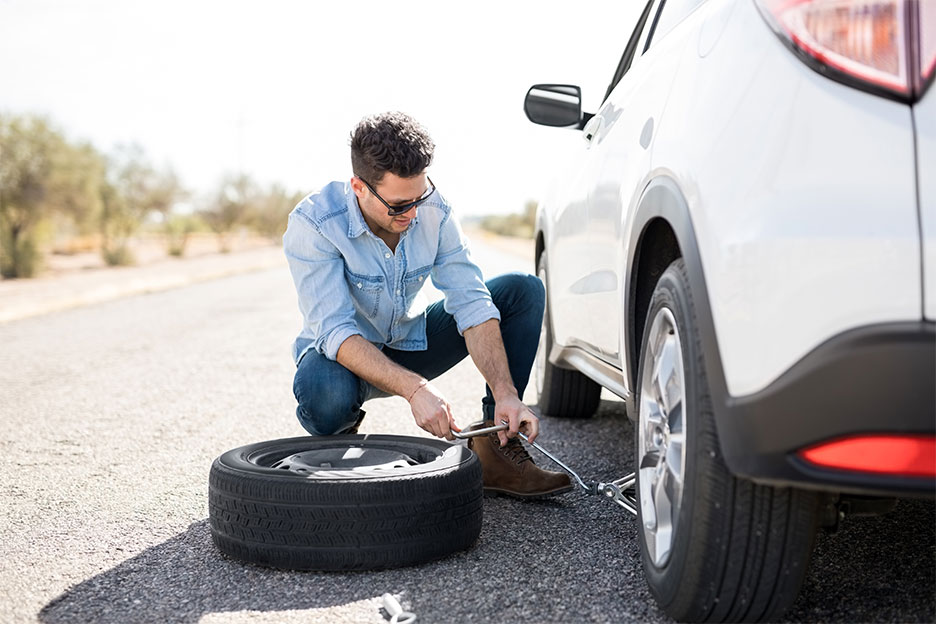- Where to pull over if you’re tire goes flat
If you have the unfortunate experience of a tire or tires going flat while traveling down the road, be sure to find an area that has solid ground and leveled out to keep your vehicle from rolling. If you’re on the side of the highway, interstate or roadway, be sure to pull over as much as possible to prevent getting struck by another vehicle and to give yourself some space to work. If at all possible, avoid pulling over where the roadway bends, as this severely reduces visibility for you and other drivers causing a major safety hazard. If you have the unfortune of blowing a tire in an unsafe or dark stretch of roadway, pull to the shoulder with your hazard lights on and slowly drive to the nearest exit, rest stop, leveled area with some work space.
- Hazard lights and parking brakes are your friend!!!
The most important thing is to be as visible as possible and you can do this by keeping those hazard lights and parking brakes on. This will increase your visibility as well as decreasing the vehicles’ ability of rolling while working.
- What do you have to work with? Let’s go down the checklist
You should ALWAYS have the following items in your vehicle just incase you do find yourself in this position
- Spare tire
- 2-ton jack
- Sockets that fit the lug nuts that are on your vehicle
- Breaker Bar
- Screw Driver
- Flashlight
- Extra lug nuts
- It’s time to get to work and loosen those lug nuts
If you have anything covering the lug nuts, they’ll need to be removed with such as hubcaps or lug nut covers, pry them off with your screw driver or plyers. Then secure the proper fitting socket onto the lug nut, and turn the breaker bar counterclockwise to loosen it just keep in mind “left loosely and righty tighty”. You’ll need to repeat this process with each of the lug nuts, making sure each lug is loose enough to be removed with the twice of your fingers
- It’s time to lift the vehicle off of the ground
Check the area to make sure that the area is flat and hard ground to so the jack will not sink into the ground when you start to lift the vehicle then you need to check the area where you’ll be placing the jack for any debris to ensure that you have a stable foundation for the jack. Now you need to find a lift point under the vehicle near the blown tire it must be a metal part of the vehicles frame. Do NOT place the jack under any plastic and do not lift the vehicle by placing the jack under the oil pan. The lift points differ depending on the vehicle. If you need to consult the vehicles owner’s manual for the best way to place the jack. Once properly positioned, use the jack to lift the tire you’re changing off of the ground. Be sure that the jack stays perpendicular to the ground at all times.
- Let’s now remove the lugs nuts and blown tire
Now that the vehicle is lift off of the ground you can finish taking the lug nuts off. Since you’ve already loosened the lugs nuts before lifting the tire all you have to do is turn the lugs counterclockwise by hand until they’re completely off. Check the lugs nuts and stems for any damage then put all the lugs together in a safe spot, you’ll obviously need them to secure the replacement tire onto the vehicle. Now that the lugs have been removed, there isn’t anything keeping the tire secured onto the vehicle. Get down onto your knee and grab the tire firmly and pull it directly out towards your body.
- It’s time to put the spare tire onto the vehicle secure it
When you get the spare to the location all you have to do is line up the holes on the spare tire with the lug nut stems and place the spare onto the rotor wheel. Push the spare as far onto the rotor wheel as possible
- Let’s put those lug nuts back on
When you put the lug nuts on to the stems in order to secure the spare do not tighten them all of the way. You should just hand tighten them evenly so that the spare doesn’t move and it stays even.
- It’s time to lower the vehicle and tighten those lugs nuts
It’s obvious that you have the jack supporting your vehicle at the moment now it’s time to lower your vehicle. Now that the vehicle is on the ground it’s time tighten the lugs nuts. Make sure you tighten the lug nuts in increments, alternating which lugs you tighten. This way you’ll keep the tire on straight. Tighten the lug nuts until they are not able to be tightened anymore.
Now, it’s time to put your wheel and flat tire into the trunk along with your tools that you used. We do not recommend repairing the flat tire and reusing it because the damage might not only be on the outside it might be on the inside of the tire. We highly recommend putting a new tire on the wheel and putting the spare back in the trunk for next time. It’s never a good idea to operate a vehicle with the spare in use for any period of time longer than it takes to get the tire replaced. You should always check your spare tire and parts to make sure it’s ready to use in case of emergency. If you need help you can always give Riggs Roadside Assistance a call at 803.288.7376

